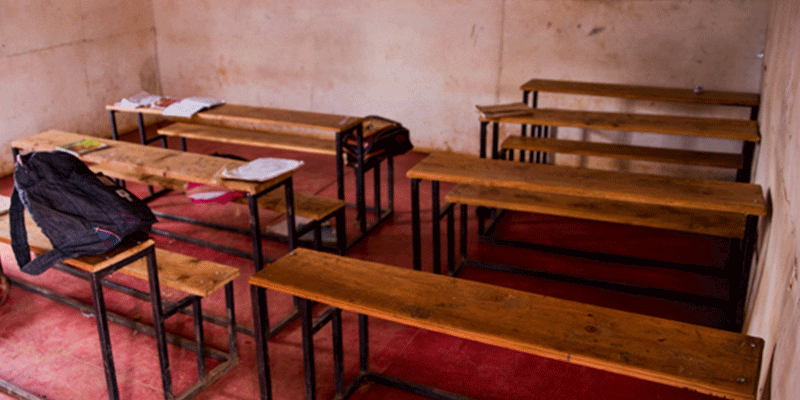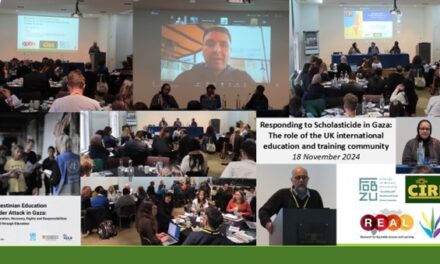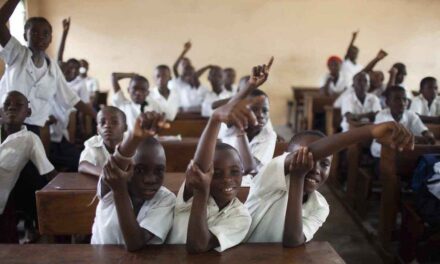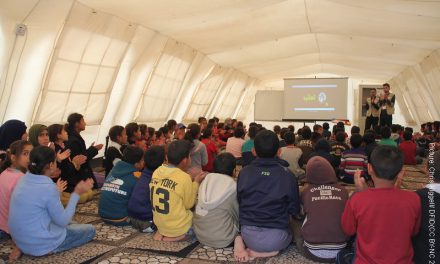This blog was written by Richard King, Strategic Growth Director at Education Development Trust and originally published on the Education Development Trust website on 31st March 2020.
Ministers of Education face hard choices as they respond to Covid-19. Within the education sector, the main response to this unprecedented crisis has been widespread school closures, with far-reaching ramifications: currently, over 1.4 billion learners (or 82.5% of learners around the world), are now affected, with 156 countries enacting nationwide closures. These closures are clearly necessary. Yet the secondary, indirect impact of such containment and mitigation measures will also be far-reaching.
This impact will be felt not just through lost learning hours, but also the lack of institutional protection that schooling usually offers, for example through school feeding programmes or support for girls in education. It is also clear that the situation is likely to be protracted. Epidemiologists predict subsequent waves of infection, and despite the best efforts of many governments to contain outbreaks, the spread of the disease in sub-Saharan Africa is potentially only just beginning. Learners, parents and teachers around the world are in this for the long haul.
As policymakers move from urgent decision-making into longer-term crisis management, the key questions will centre on how to maintain learning and limit the secondary impacts. There are no easy answers. How is it possible to ensure an education system facing severe and sustained disruption – with widespread remote schooling – can still function to maximise learning and mitigate the impact of disruption on the most vulnerable? In doing so, how is it possible to ensure the education system contributes to the wider response to Covid-19? These questions are relevant now, in this initial response phase, but they will remain relevant for many months to come as school systems begin to partially or fully recover.
At Education Development Trust, these questions matter to us. As an evidence-based not-for-profit organisation working with governments to improve education systems, we are – like many others – working hard to develop answers within our teams, with government partners, and beyond. History offers us no straightforward precedents. New thinking is required. But a number of key considerations are already emerging which may be important for policymakers as attention turns to how we can sustain learning at scale, despite the challenges presented by this global pandemic:
1. Promote quality in remote schooling
The education sector has rightly rallied around school systems to offer a wide array of solutions for ministries. These are mostly focused on solving the challenge of shifting to remote schooling, with the majority of solutions related to education technology. The scale of response and swiftness with which ministries and schools have reorganized has been remarkable. But deciding which remote schooling methods and tools to use can be overwhelming, especially where learners across a system have a wide variety of technological, economic and social needs. What can best guide a ministry in that process? There are no universally accepted standards on what ‘quality’ means in remote forms of learning, and nor are there clear guidelines on what criteria would make one option better than another. This is something we are actively working on. Moreover, we believe there is an urgent need for broader discussions on this topic, for dissemination of relevant information, and for support for ministries and schools.
2. Do not neglect low-tech or no-tech solutions
Education technology will enable learning to continue for many of the 1.4 billion learners currently out of school. But for a significant proportion of these learners, technological solutions will not help. The digital divide is a real and pressing issue and focusing solely on ed-tech risks perverse consequences, potentially widening educational inequalities – not just in low-income countries, but in all countries. Alternatives to ed-tech exist and there is evidence that they work. TV and radio broadcasting can be cheap and effective, as can the use of feature mobile phones (e.g. through SMS). The targeted distribution of materials, for example, textbooks for maths and reading, could also prove to be an important strategy. We urge ministries to consider all options, including how creative combinations of high- and low-tech strategies could maximise impact.
3. Plan creative ways to maintain learner engagement
The initial focus of many government efforts has been getting content to learners in its various forms. However, fatigue will set in as overstretched parents and learners who are not used to being self-guided feel less motivated to engage. Finding ways to build in interaction, even remotely, and drip-feeding content using engaging methods will be essential – especially where mass broadcasts are the only option. Creative ways to enable feedback (e.g. via SMS) may help, along with prizes, competitions and use of social media or WhatsApp, where possible. Peer role models, or the use of influential community members to promote the importance of home-learning (and potentially play a role in the delivery of materials) could also be key strategies.
4. Make teachers a focus of your response
With the current focus on learners and parents, it may be easy to forget the teaching workforce. Governments should continue to pay teachers but expectations regarding the important work that teachers will undertake during the crisis should also be made clear. Teachers are not only a potential resource to assist with remote learning: they will also have a critical role when schools reopen. Maintaining teachers’ motivation is essential. Measures to do so could include giving teachers a role (for example, as remote tutors for specific children), using peer engagement via social media or local groups (e.g. using WhatsApp), and – critically – providing them with remote professional development opportunities to support schools reopening. Such training could include a focus redesigning accelerated curricula and utilising new approaches to technology in school.
5. Focus on the most vulnerable
A critical concern will be how vulnerable children will cope. In some protracted conflict or crisis settings, the majority of children may be classified as vulnerable. What will be the impact, for example, on girls who are out of school, those forced to work due to the looming economic shock, children with disabilities, or those in abusive home environments for whom school can be a refuge? There must be a dedicated focus on protecting the most vulnerable from harm and targeting additional resources to support them. Supplementary support packages, targeted device distribution, safe spaces and community volunteers may all be necessary. Cross-sectoral approaches, such as working with health and social-care systems, will also be key to enable appropriate identification and targeting of resource to help protect the most vulnerable.
6. Use all available human resource across the system
Education systems have multiple functions in addition to teaching, including assessment, data management and inspection. Dedicated teams of people support each function, and in a new, fragmented and remote world, there will be smart ways to use the teaching and wider education system workforce. This might include developing remote assessment guidance for learners or parents to use, using teachers in remote assessment hubs to mark work and respond to questions, redeploying supervisors or inspectors to review the resource delivery arrangements of specific schools, and tasking curriculum teams with the development of remote summative assessments and examinations. It will be important to give all teams a clear role throughout the crisis, remembering to plan for sickness or enforced absence in the process.
7. Embrace cross-sectoral solutions
We know from early years interventions and gender-based programming that cross-sectoral approaches can have significant power. Therefore, policymakers need to ask key questions as to how the education system can support the health system response (for example, teachers could be asked to contact parents or pupils to reinforce health messages) and how the health or social sectors can support the maintenance of learning. For instance, targeted testing could be used to identify multi-sectoral teams of teachers and/or health workers to work in socially isolated ‘enclaves’ to support vulnerable families. Bringing education and health planners together will help to ensure alignment and better enable them to identify creative ideas as the crisis response evolves.
8. Help parents manage the home learning environment
The burden of managing learning is currently falling largely on parents. For some children, this will work, but even in the most well-off systems, many parents will be time-poor and pressured. This pressure will only increase. It will be crucial to find ways to reduce the burden on parents – for example, by providing them with information about educational content on radio or television or giving advice on home learning and the structure of the day. Parents might also benefit from initiatives encourage children to read aloud to others in the household or encourage older children to assist the learning of younger siblings, as well as support in assisting children self-managing learning. Decision-makers could also consider the curation of additional content channels (e.g. YouTube) and using teachers to provide coaching support to or answer questions from those struggling the most.
9. Plan now for schools reopening and envision a more resilient and effective system
Schools will reopen. How and when this happens will vary, and closures may become periodic. But when this process begins, a host of challenges will remain. Remote learner engagement will be patchy even in systems with the best resources, making differentiation and catch-up solutions essential. In some systems, approaches like teaching at the right level (TARL) may be required. There may also be an opportunity to harness the technology that has proven to work during the crisis to support the most vulnerable and learners with additional needs. This might include personalized learning driven by artificial intelligence. In some systems, drop-out rates will unfortunately be high, so maintaining cross-sectoral approaches to provide structured re-entry pathways into school or vocational training will also be necessary. This may currently seem a distant prospect, but planning now could help to both identify ways to mitigate the re-entry challenge and imagine a better, more resilient system beyond the crisis. This will include more effective use of technology, differentiation and personalization, which will not only allow accelerated catch-up, but lay the foundations for better learning for all.
We do not underestimate the scale of this challenge. Our message to partners and friends at this time of crisis is that we need to work together – not only to rapidly identify effective remote schooling approaches, but also to find creative and practical solutions that will mobilise the whole system, maximise learning, and build resilience – both during and beyond the Covid-19 crisis. The situation will look different in every country. Not all proposed solutions will necessarily work: we will need to ‘fail fast’ and adapt, building and augmenting the evidence base. Crucially, we need all the creative endeavour available to avoid the worst secondary impacts of Covid-19 in education and prevent a lost learning generation.





